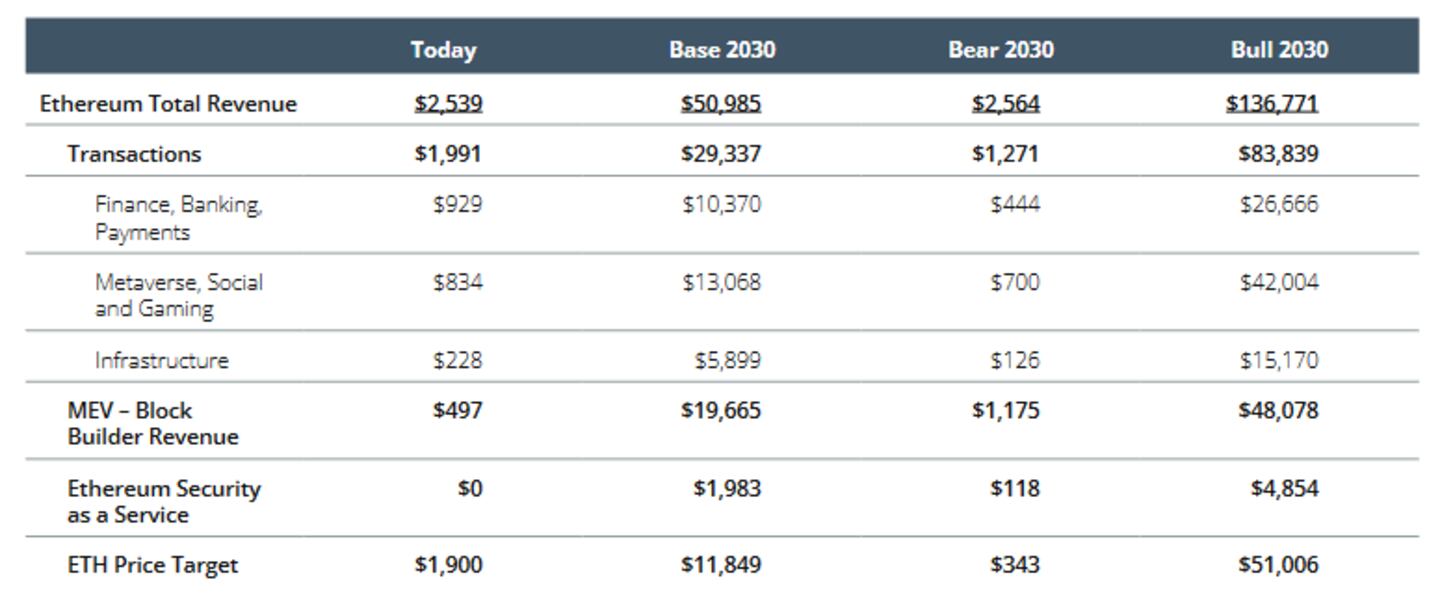- VanEck’s bullish scenario for Ether predicts a 27-fold price surge by 2030.
- The asset manager says it expects Ethereum to remain the dominant blockchain settlement network.
Ether, the transactional cryptocurrency of the Ethereum network, could be worth $300 by the year 2030. Or it could soar as high as $51,000.
This is according to a prediction by investment management firm VanEck — the company sees $11,800 as a “base case” Ether price in a report released this month.
Based on VanEck’s predictions, Ether could be up 27-fold or be down 83% from its current $1,800 price in the next seven years.

For the more bullish prediction: “We base these estimates on the thesis that Ethereum becomes the dominant open-source global settlement network, that hosts substantial portions of the commercial activity of business sectors with the highest potential to gain from moving their business functions to public blockchains.”
VanEck doesn’t outline its bear case, where the price could plunge to as low as $343. But in a volatile asset class, where blowups have littered the crypto industry over the past year, it’s wise to hedge one’s bets.
VanEck’s bull case for Ethereum
VanEck sees Ethereum prevailing over other alternative layer 1 blockchain networks, even as more competitors with venture capital backing continue to enter the fray. VanEck noted that the firm has positions in Ether.
Ethereum’s dominance of the smart contract blockchain space could have significant financial benefits for the project, according to VanEck’s report. The investment manager predicts that Ethereum’s annual revenue will hit $51 billion by 2030, a 20-fold increase from its current level.
‘People are relying more and more on the Ethereum chain’
VanEck pinned this prediction to its expectation that Ether will become more than a transactional currency.
“ETH, while not a complete store of value like Bitcoin due to Ethereum’s demonstrated mutability of code and an evolving social consensus focused on utility, will nevertheless become a store-of-value asset for state actors looking to maximise human capital (versus Bitcoin, which maximises for stranded energy),” the report said.
NOW READ: Why Ethereum is so dominant — and why it’s not going anywhere
Ethereum’s adoption is also expected to continue to grow, especially with the level of developer activity on the network, said Danny Chong, co-founder of yield management protocol Tranchess.
“People are relying more and more on the Ethereum chain, and confidence in it has continuously increased,” Chong told DL News. “I expect more institutions to become involved in staking. At the same time, the ecosystem has already grown exponentially, with many new types of protocols coming in to bolster the demand.”
The dominant layer 1
Several “Ethereum killers” have been launched by different project teams. These networks often claimed to be superior to Ethereum by offering faster transaction speeds at cheaper costs.
But these cheaper-to-use alternative layer 1 chains have been unable to knock Ethereum off its perch. Ethereum continues to dominate all other layer 1 networks in terms of economic activity.
It currently controls a larger share of the decentralised finance market, accounting for more than half of the total value locked into DeFi protocols, DefiLlama data shows.
Some of Ethereum’s competitors have been affected by scandals. The Terra ecosystem collapsed in May 2022 and FTX, a major backer of the Solana blockchain, collapsed in November. The likes of Fantom, Harmony, and Waves have also not fared any better.


